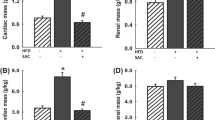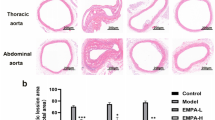Abstract
Purpose
The purpose of the study is to identify potential mechanisms involved in the cardiac protective effects of sitagliptin in Zucker diabetic fatty (ZDF) rats.
Methods and Results
Male non-diabetic lean Zucker rats (Lean) and ZDF rats treated with saline (ZDF) or sitagliptin (ZDF + sita) were used in this study. The blood pressure and lipid profiles were increased significantly in ZDF rats compared with Lean rats. ZDF + sitagliptin rats had decreased systolic blood pressure compared with ZDF rats. Sitagliptin treatment decreased total cholesterol (TC), triglycerides (TGs), low-density lipoprotein (LDL), and high-density lipoprotein (HDL) levels. Ejection fraction (EF) and fractional shortening (FS) were decreased in ZDF rats, which improved with sitagliptin from 59.8% ± 3.0 and 34.5% ± 3.1 to 66.9% ± 3.4 and 40.9% ± 4.2, respectively. Moreover, the nitroxidative stress level was increased while autophagy levels were decreased in ZDF rats, which was reversed by the administration of sitagliptin. Treatment with sitagliptin or FeTMPyP improved the autophagy level in high-glucose cultured H9c2 cells by increasing autolysosome numbers from 15 ± 4 to 21 ± 3 and 22 ± 3, respectively. We detected a positive correlation between DPP-4 activity and 3-nitrotyrosine levels (r = 0.3903; P < 0.01), a negative correlation between Beclin-1 levels and DPP-4 activity (r = − 0.3335; P < 0.01), and a negative correlation between 3-nitrotyrosine and Beclin-1 levels (r = − 0.3794; P < 0.01) in coronary heart disease patients.
Conclusions
Sitagliptin alleviates diabetes-induced cardiac injury by reducing nitroxidative stress and promoting autophagy. This study indicates a novel target pathway for the treatment of cardiovascular complications in type 2 diabetes mellitus.





Similar content being viewed by others
References
Cho NH, Kirigia J, Mbanya JC, Ogurstova K, Guariguata L, Rathmann W, et al. IDF DIABETES ATLAS. 8th ed. International Diabetes Federation; 2017.
Röhrborn D, Wronkowitz N, Eckel J. DPP4 in diabetes. Front Immunol. 2015;6.
Green JB, Bethel MA, Armstrong PW, Buse JB, Engel SS, Garg J, et al. Effect of sitagliptin on cardiovascular outcomes in type 2 diabetes. N Engl J Med. 2015;373(3):232–42.
Read PA, Khan FZ, Heck PM, Hoole SP, Dutka DP. DPP-4 inhibition by sitagliptin improves the myocardial response to dobutamine stress and mitigates stunning in a pilot study of patients with coronary artery disease. Circ Cardiovasc Imaging. 2010;3:195–201.
McCormick LM, Kydd AC, Read PA, Ring LS, Bond SJ, Hoole SP, et al. Chronic dipeptidyl peptidase-4 inhibition with sitagliptin is associated with sustained protection against ischemic left ventricular dysfunction in a pilot study of patients with type 2 diabetes mellitus and coronary artery disease. Circ Cardiovasc Imaging. 2014;7:274–81.
Yamada H, Tanaka A, Kusunose K, Amano R, Matsuhisa M, Daida H, et al. Effect of sitagliptin on the echocardiographic parameters of left ventricular diastolic function in patients with type 2 diabetes: a subgroup analysis of the PROLOGUE study. Cardiovasc Diabetol. 2017;16(1):63.
Cai L, Wang Y, Zhou G, Chen T, Song Y, Li X, et al. Attenuation by metallothionein of early cardiac cell death via suppression of mitochondrial oxidative stress results in a prevention of diabetic cardiomyopathy. J Am Coll Cardiol. 2006;48(8):1688–97.
Filomeni G, De Zio D, Cecconi F. Oxidative stress and autophagy: the clash between damage and metabolic needs. Cell Death Differ. 2015;22(3):377–88.
Yang Y, Zhao C, Yang P, Wang X, Wang L, Chen A. Autophagy in cardiac metabolic control: novel mechanisms for cardiovascular disorders. Cell Biol Int. 2016;40(9):944–54.
Mizushima N, Levine B, Cuervo AM, Klionsky DJ. Autophagy fights disease through cellular self-digestion. Nature. 2008;451(7182):1069–75.
Linton PJ, Gurney M, Sengstock D, Mentzer RM Jr, Gottlieb RA. This old heart: cardiac aging and autophagy. J Mol Cell Cardiol. 2015;83:44–54.
Ishibashi Y, Matsui T, Takeuchi M, Yamagishi S. Sitagliptin augments protective effects of GLP-1 against advanced glycation end product receptor axis in endothelial cells. Horm Metab Res. 2011;43:731–4.
Liu L, Liu J, Tian XY, Wong WT, Lau CW, Xu A, et al. Uncoupling protein-2 mediates DPP-4 inhibitor-induced restoration of endothelial function in hypertension through reducing oxidative stress. Antioxid Redox Signal. 2014;21:1571–81.
Wang H, Zhou Y, Guo Z, Dong Y, Xu J, Huang H, et al. Sitagliptin attenuates endothelial dysfunction of Zucker diabetic fatty rats: implication of the antiperoxynitrite and autophagy. J Cardiovasc Pharmacol Ther. 2018;23(1):66–78.
Steven S, Oelze M, Hanf A, Kröller-Schön S, Kashani F, Roohani S, et al. The SGLT2 inhibitor empagliflozin improves the primary diabetic complications in ZDF rats. Redox Biol. 2017;13:370–85.
Williams D, Feely J. Pharmacokinetic-pharmacodynamic drug interactions with HMG-CoA reductase inhibitors. Clin Pharmacokinet. 2002;41:343–70.
Herman GA, Bergman A, Yi B, Kipnes M, Sitagliptin Study 012 Group. Tolerability and pharmacokinetics of metformin and the dipeptidyl peptidase-4 inhibitor sitagliptin when co-administered in patients with type 2 diabetes. Curr Med Res Opin. 2006;22:1939–47.
Wright DH, Herman GA, Maes A, Liu Q, Johnson-Levonas AO, Wagner JA. Multiple doses of sitagliptin, a selective DPP-4 inhibitor, do not meaningfully alter pharmacokinetics and pharmacodynamics of warfarin. J Clin Pharmacol. 2009;49:1157–67.
Plosker GL. Sitagliptin: a review of its use in patients with type 2 diabetes mellitus. Drugs. 2014;74(2):223–42.
Lee M, Rhee MK. Sitagliptin for type 2 diabetes: a 2015 update. Expert Rev Cardiovasc Ther. 2015;13(6):597–610.
Masuda D, Kobayashi T, Sairyou M, Hanada H, Ohama T, Koseki M, et al. Effects of a dipeptidyl peptidase 4 inhibitor sitagliptin on glycemic control and lipoprotein metabolism in patients with type 2 diabetes mellitus (GLORIA trial). J Atheroscler Thromb. 2017;25:512–20.
Navar AM, Gallup DS, Lokhnygina Y, Green JB, McGuire DK, Armstrong PW, et al. Hypertension control in adults with diabetes mellitus and recurrent cardiovascular events: global results from the trial evaluating cardiovascular outcomes with sitagliptin. Hypertension. 2017;70(5):907–14.
Saito Y, Ishikawa J, Harada K. Postprandial and orthostatic hypotension treated by sitagliptin in a patient with dementia with Lewy bodies. Am J Case Rep. 2016;17:887–93.
Matsubara J, Sugiyama S, Sugamura K, Nakamura T, Fujiwara Y, Akiyama E, et al. A dipeptidyl peptidase-4 inhibitor, des-fluoro-sitagliptin, improves endothelial function and reduces atherosclerotic lesion formation in apolipoprotein E-deficient mice. J Am Coll Cardiol. 2012;59(3):265–76.
Huang CY, Shih CM, Tsao NW, Lin YW, Huang PH, Wu SC, et al. Dipeptidyl peptidase-4 inhibitor improves neovascularization by increasing circulating endothelial progenitor cells. Br J Pharmacol. 2012;167(7):1506–19.
Liu L, Liu J, Wong WT, Tian XY, Lau CW, Wang YX, et al. Dipeptidyl peptidase 4 inhibitor sitagliptin protects endothelial function in hypertension through a glucagon-like peptide 1-dependent mechanism. Hypertension. 2012;60(3):833–41.
Hemmeryckx B, Swinnen M, Gallacher DJ, Rong LH, Roger LH. Effect of sitagliptin treatment on metabolism and cardiac function in genetically diabetic mice. Eur J Pharmacol. 2014;723:175–80.
Hamdani N, Hervent AS, Vandekerckhove L, Matheeussen V, Demolder M, Baerts L, et al. Left ventricular diastolic dysfunction and myocardial stiffness in diabetic mice is attenuated by inhibition of dipeptidyl peptidase 4. Cardiovasc Res. 2014;104:423–31.
Ke X, Ke B, Wang X, Wu S, Yang R, Hu C. Additive effects of atorvastatin combined with sitagliptin on rats with myocardial infarction: a pilot study. Arch Med Sci. 2017;13:956–61.
Al-Rasheed NM, Al-Rasheed NM, Hasan IH, Al-Amin MA, Al-Ajmi HN, Mahmoud AM. Sitagliptin attenuates cardiomyopathy by modulating the JAK/STAT signaling pathway in experimental diabetic rats. Drug Des Devel Ther. 2016;10:2095–107.
Ye Y, Keyes KT, Zhang C, Perez-Polo JR, Lin Y, Birnbaum Y. The myocardial infarct size-limiting effect of sitagliptin is PKA-dependent, whereas the protective effect of pioglitazone is partially dependent on PKA. Am J Physiol Heart Circ Physiol. 2010;298(5):H1454–65.
Chang G, Zhang P, Ye L, Lu K, Wang Y, Duan Q, et al. Protective effects of sitagliptin on myocardial injury and cardiac function in an ischemia/reperfusion rat model. Eur J Pharmacol. 2013;718:105–13.
Maiztegui B, Boggio V, Román CL, Flores LE, Zotto HD, Ropolo A, et al. VMP1-related autophagy induced by a fructose-rich diet in β-cells: its prevention by incretins. Clin Sci (Lond). 2017;131(8):673–87.
Wang XM, Yang YJ, Wu YJ, Zhang Q, Qian HY. Attenuating hypoxia-induced apoptosis and autophagy of mesenchymal stem cells: the potential of sitagliptin in stem cell-based therapy. Cell Physiol Biochem. 2015;37(5):1914–26.
Wang HJ, Zhang D, Tan YZ, Li T. Autophagy in endothelial progenitor cells is cytoprotective in hypoxic conditions. Am J Phys Cell Phys. 2013;304(7):C617–26.
Leibovitz E, Gottlieb S, Goldenberg I, Gevrielov-Yusim N, Matetzky S, Gavish D. Sitagliptin pretreatment in diabetes patients presenting with acute coronary syndrome: results from the Acute Coronary Syndrome Israeli Survey (ACSIS). Cardiovasc Diabetol. 2013;12:53.
Steven S, Hausding M, Kröller-Schön S, Mader M, Mikhed Y, Stamm P, et al. Gliptin and GLP-1 analog treatment improves survival and vascular inflammation/dysfunction in animals with lipopolysaccharide-induced endotoxemia. Basic Res Cardiol. 2015;110(2):6.
Pacheco BP, Crajoinas RO, Couto GK, Davel AP, Lessa LM, Rossoni LV, et al. Dipeptidyl peptidase IV inhibition attenuates blood pressure rising in young spontaneously hypertensive rats. J Hypertens. 2011;29(3):520–8.
Acknowledgments
We appreciate Mrs. Qing Xu for the help with Doppler ultrasound for cardiac function detection in the Core Facility Center, Capital Medical University (Bei**g, China). We also thank Dr. Qian Fan and Ms. **aochun Yang for collecting the serum samples of CHD patients in Beijng Anzhen Hospital.
This work was funded by the Natural Science Foundation of Bei**g (no. 7151001) and Scientific Research Foundation of Bei**g Key Laboratory of Metabolic Disorders Related Cardiovascular Diseases (no. 2015DXWL03). We thank Edanz Group China (www.liwenbianji.cn/ac) for editing the English text of this manuscript.
Author information
Authors and Affiliations
Contributions
Wen Wang, Qi Pan, Zhiying Guo, and Yi Zhou contributed to the conception and design of the study. Yi Zhou drafted the article. Yi Zhou, Huanyuan Wang, Zhiying Guo, and Jiahui Xu performed the experiments, data acquisition, and data analysis. Fuli Man, Wen**g Yan, Jiahui Xu, and Jiaying Li critically revised the article, gave final approval, and agreed to be accountable for all aspects of work ensuring integrity and accuracy.
Corresponding authors
Ethics declarations
Conflict of Interest
The authors declare that they have no conflict of interest.
Research Involving Animals
All procedures performed in studies involving animals were in accordance with the “Guiding Principles in the Use and Care of Animals” published by the National Institutes of Health (NIH Publication No. 85-23, Revised 1996) and approved by the Institutional Animal Care and Use Committee of Capital Medical University.
Research Involving Human Participants
All procedures performed in studies involving human participants were in accordance with the ethical standards of the institutional and/or national research committee and with the 1964 Helsinki declaration and its later amendments or comparable ethical standards. All subjects have been informed of the purpose and nature of this study and given written informed consents. The study was approved by the local research ethics committee (Bei**g Anzhen Hospital, Capital Medical University, Bei**g, China).
Rights and permissions
About this article
Cite this article
Zhou, Y., Wang, H., Man, F. et al. Sitagliptin Protects Cardiac Function by Reducing Nitroxidative Stress and Promoting Autophagy in Zucker Diabetic Fatty (ZDF) Rats. Cardiovasc Drugs Ther 32, 541–552 (2018). https://doi.org/10.1007/s10557-018-6831-9
Published:
Issue Date:
DOI: https://doi.org/10.1007/s10557-018-6831-9




